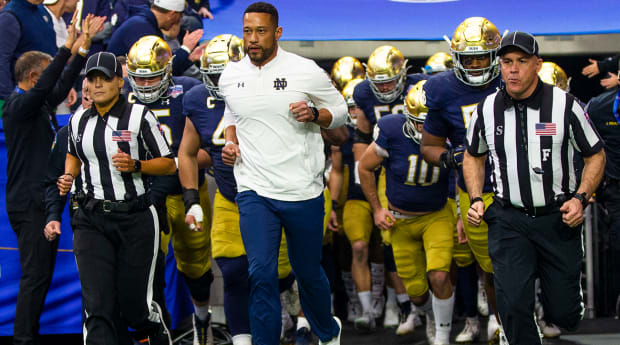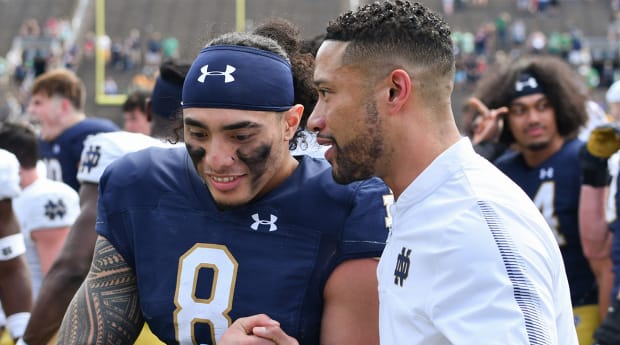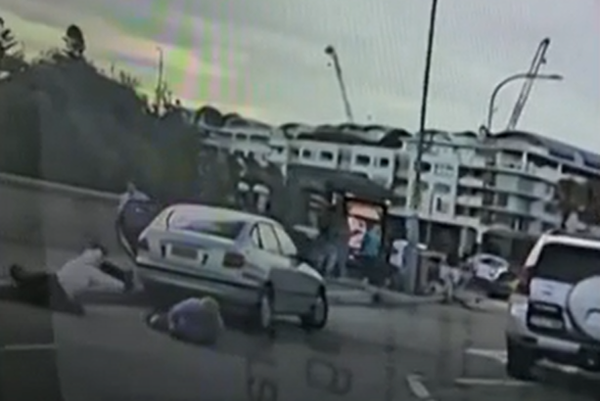SOUTH BEND, Ind. — A small passel of people was heading into the side entrance of the Guglielmino Athletics Complex—the nerve center of Notre Dame football—on Friday afternoon. Coincidentally, the head coach of the Fighting Irish at that moment stepped out onto the balcony of his second-floor office to inhale what he represents to many people here: a breath of fresh air.
“Don’t jump!” joked Irish athletic director Jack Swarbrick, looking up at Marcus Freeman. “It’s not that bad!”
“Might need to build this wall a little higher,” Freeman cracked in return.
It wasn’t quite the balcony scene in Romeo and Juliet, but the bromance between Swarbrick and Freeman is real. The two have invested heavily in each other.
Suddenly spurned last winter by the winningest coach in school history, Brian Kelly, Swarbrick surprisingly truncated his search for a successor by promoting Freeman. With multiple high-profile head coaches interested in the job and some scheduled for interviews, Swarbrick instead quickly chose to ride with a 35-year-old defensive coordinator (now 36) who had worked at Notre Dame for less than a year.

South Bend Tribune/USA TODAY Sports
Too rash, too unadvised, too sudden? Too like the lightning, which doth cease to be? Five months into the job, the whirlwind courtship is showing the promise of a beautiful long-term relationship. There is much yet to prove on the field, but the Freeman–Notre Dame marriage has the potential to bring out the best in each other.
It didn’t take long for the public to understand what Swarbrick—and the Fighting Irish players who championed Freeman’s candidacy—saw in him: a charismatic leader and communicator; a high-voltage energy source; a younger man who connects authentically with college athletes. “He just drips EQ,” Swarbrick said, dropping the shorthand for emotional intelligence.
Plugging those personality traits into a Notre Dame recruiting machine that is ramping up to match the current terrain has yielded spectacular early results. The Irish currently have the No. 1 recruiting class in the nation for 2023 with 247Sports and No. 2 with Rivals. With nine four-star commitments and one five-star pledge, Notre Dame’s per-recruit ranking is second only to USC’s.
The Irish have commitments from players at seven positions and from eight states, and remain in the hunt for several more high-profile prospects in the Class of 2023. Most notable among them: Detroit quarterback Dante Moore, a consensus national top-10 recruit. That recruitment could come down to a battle between Notre Dame and Michigan, though others are in the mix as well (including Kelly and LSU).
Things can change, of course. Having a top-ranked class now and actually signing it in December/February can be two different things. But Freeman has the Irish on track for their best single-season recruiting haul since 2013, at least.
“In connecting with top recruits this spring, there is a sense that Freeman's modern recruiting style, aggression and ability to resonate has many thinking he could bridge the talent gap that has plagued the Irish in big games,” said John Garcia Jr., director of football recruiting for SI All-American. “The foundation of the 2023 recruiting class already features heavyweight wins over blueblood programs, along with the classic national Notre Dame reach.
“Their 2023 class has a chance to pick up even more momentum following its spring game weekend, to the point that the program could be in position to contend for a No. 1-ranked recruiting class both at the outset and most importantly at the end of the cycle. Notre Dame hasn't been near that tier in a decade.”
Thus far, this is a case of right man, right place, right time. The recruiting landscape is changing wildly in the Name, Image and Likeness era, and the Irish have mobilized accordingly. Last week the school announced the Friends of the University of Notre Dame collective (FUND), which is headed by former star quarterback Brady Quinn and has input from no less than the alumnus who has his name on the university’s renowned business school, Tom Mendoza.
This being Notre Dame, the FUND concept is not going to be crassly commercial. Per its website, compensation is tied to “student-athletes looking to be ambassadors for charities of their own choice.” But its existence still is centered on putting NIL money in players’ pockets, just as it is at other FBS programs.
“Unilateral disarmament is never a great idea,” Swarbrick said dryly.
With its vast network of affluent alums who also want very much to see Notre Dame get back into the business of winning national championships, the potential for NIL-related recruiting power is significant. There is the allure of a degree from a top-20 national university. And ND now has a coach capable of selling the school like never before.
“This is the greatest opportunity for a young person to have success,” Freeman said. “It offers you a chance to have success in the sport of football, but long after football is done. That’s what makes this place so unique—you’re not cheating yourself in any area. You’re giving yourself a bright future in the sport you play, in academics, and in the network that helps you after football.”
Freeman stopped and laughed.
“We’ve been relentless.”

Matt Cashore/USA TODAY Sports
Freeman is the tip of the Notre Dame recruiting spear, by his own insistence. “I’d better be the lead recruiter on every kid that we recruit,” he said at his introductory press conference, and he’s tried to follow through with that approach.
“I’ve gotten involved with everybody,” he said, requesting regular staff meetings to see where the Irish stand with recruits and how much of his time to invest with each of them. “Are these the guys you want me spending time with? Are we moving the needle? Is it trending in the right direction? If it’s not, let’s turn my attention elsewhere.”
Notably, Notre Dame is turning its attention to some places where it hasn’t before. The Irish are casting a wider net, beyond the usual “profile” players from Catholic schools. There are public schools in urban areas that haven’t seen Fighting Irish recruiters before, but are now.
Take, for example, Dante Moore’s Detroit high school, Martin Luther King Jr. It has produced more than a dozen NFL players, none of whom attended Notre Dame. Big Ten schools have recruited there routinely. Now the Irish are in the door with them.
“It’s easy to identify the profile kids,” Freeman said. “They’re doing good in a private school, in a Catholic school, and we know they would make the transition. To me, the challenge is, let’s go find the best players in the country, let’s identify them, then figure out if they fit this place. Look at their transcript and talk to people and find out. Our mindset now is, let’s look at the best players in the country and then let’s say, ‘OK, can this person be a fit here at Notre Dame?’ Instead of looking and saying, ‘This guy’s a fit, now is he a good player?’
“That might take more time, but that’s O.K.”
In addition to recruiting in new places, Notre Dame is wide open to recruiting in new ways—and not just in terms of NIL. Freeman embraces the traditional trappings of the place—he can wax poetic about “the lady on the Golden Dome”—but he can channel his inner Lane Kiffin as needed.
Part of Moore’s March campus visit was posing in uniform on a “golden chair” with a Heisman Trophy on his lap. If over-the-top is what sells in 2022, well, the traditionally stuffy Irish are unashamedly ready to max out.
The old coach, Kelly, also has turned up the ham factor since moving to LSU. There were no known videos of him dancing with recruits while at Notre Dame, where the program vibe was more rigid and aloof than it is now. Freeman has big shoes to fill in terms of organization, scheme and in-game coaching, but he’s already executed a striking personality makeover within “The Gug.”
“It’s more fun,” said defensive end Isaiah Foskey. “[Freeman] makes competition fun.”
The level of wariness in the building has dropped to the point that, with staffers scurrying in different directions last Friday, I had free rein to poke my head in offices and look around. That included the big office with the balcony.
It’s a welcoming place: pictures of Freeman with his wife and six children all over; a scented candle dispenses a soothing aroma; big glass jars of Starbursts and chocolate truffles sit invitingly on a table. (Who among us hasn’t found it easier to bond over some candy?) Players who gravitated to Freeman’s office when he was a coordinator have the same open-door privileges now.
“His level of engagement is so much greater,” Swarbrick said.
Part of the new tenor is a concerted outreach to former players, whom Swarbrick described as “disconnected” during Kelly’s tenure. Director of player development Hunter Bivin organized a player alumni weekend centered around Saturday’s Blue-Gold spring game, and the turnout was massive: 297 former players returned to campus.
Among the activities: a networking dinner with all the current players, who sat with alumni and heard their stories. Swarbrick was particularly tickled to pair current tight end star Michael Mayer with the OG Fighting Irish tight end, Dave Casper, a national champion at Notre Dame and Super Bowl champion with the Oakland Raiders in the 1970s.
While engaging with alumni and current players comes naturally to Freeman, there is a learning curve involved in becoming the head coach. Part of being the program CEO is worrying about everything, and not simply burrowing into the niche comfort of being a position coach or coordinator.
“I couldn’t figure out why, but I’m out at [spring] practice and I’m not having enough fun,” Freeman said. “Practice three or four, I figured it out—I don’t have anybody to cheer for. As a head coach, you lose that competitive spirit sometimes at practice. As a defensive coordinator, whatever it takes to win, let’s win. Win this team period, win this drill. But as the head coach, you want both teams to win. You want the offense to do well and the defense to do well, make sure the flow of practice is right. You lose the competitive side. But those 12 Saturdays in the fall, I’ll be as competitive as I can be.”
The first Saturday in the fall is a massive test, at Ohio State, Freeman’s alma mater. The Irish have a lot of ground to cover between now and then. The spring game had a dramatic ending, with freshman early enrollee Steve Angeli scrambling for the winning touchdown on the final play, but there were a few misfires prior to that. Pre-snap penalties were an issue, including two that wiped out a touchdown and an interception on successive plays. Quarterback Drew Pyne, who saw most of the action after an ankle injury to Tyler Buchner, struggled to the point that it should be Buchner’s job to lose heading into fall camp.
Will Notre Dame be ready to win in the Horseshoe by Labor Day weekend? Who knows? We’re about halfway between the start of the Freeman era at the school and that game, and there will be many long days and nights of work to prepare for it. (Among the people Freeman assuredly will consult between now and then is his former coach at Ohio State, Jim Tressel, a confidant and mentor.)
But there also has to be a break. Freeman’s wife, Joanna, unilaterally scheduled her husband a week off in July for a Disney Cruise with the whole family. “I could spend every day, all day, in this office and have plenty of work to do,” Freeman said. “You need to have people you trust to say, ‘You need to get out of here.’”
Freeman will take the stairs out. There’s no need for a balcony leap, not yet. It’s early in his bromance with Swarbrick, and the honeymoon phase is still going strong.







